Related Research Articles

The Göppingen Gö 4 or Goevier is a German sailplane of the late 1930s used for training pilots. Its most notable features include side-by-side seating and dual controls, making the plane ideal for use as a trainer. It boasted average performance, compared to other gliders of the day, and was advertised as making the process of learning to fly sailplanes easier.
The FVA 1 Schwatze Düvel was a glider produced in Germany in 1920. It was a highly streamlined, thick winged cantilever monoplane.
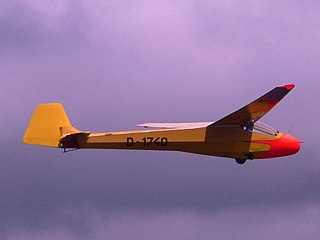
The Akaflieg München Mü17 Merle is a single-place glider aircraft that was designed and built in Germany from 1938.

The Schleicher Condor, also referred to as the Dittmar Condor, is a series of German high-wing, single and two-seat, gull winged, gliders that were designed by Heini Dittmar in the 1930s, produced in small quantities before the Second World War, produced again between 1952 and 1955 by Alexander Schleicher GmbH & Co and also by Ferdinand Schmetz.
The Akaflieg Darmstadt D-28 Windspiel was a single-seat, high-performance sailplane designed in Germany in the early 1930s. Intended to exploit a growing understanding of thermal soaring, it was small and manoeuvrable, with a 12 m span; silk-covered for lightness, it weighed less (empty) than its pilots. It held the world straight-line distance record for a time in 1934.
The FVA-20 F. B. Schmetz was a single seat, Standard Class sailplane, built as a one-off aircraft, to explore the application of glass fibre to glider construction. Built over a long period, it finally flew in late 1979.

The Arsenal Air 100 is a French single seat competition sailplane produced in the 1940s. It sold in small numbers but set several records, still holding the world absolute solo glider endurance record of 56 h 15 m.
The Bréguet Br 900 Louisette was a short-span, single-seat competition sailplane built in France in the 1940s. It set some French gliding records but was unsuccessful at the international level. Only six production aircraft were built.
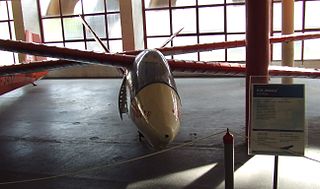
The Rubik R-25 Mokány, in English: Plucky person and sometimes known as the R-25 Standard (class), is a Hungarian single seat Standard Class glider of all-metal construction, first flown in 1960. It was one of a series of similar aircraft designed by Ernő Rubik. Only one was built.
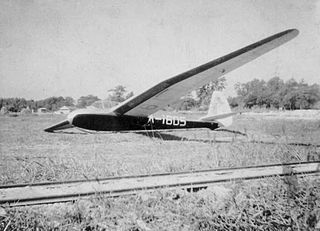
The Maeda 703 was one of the first indigenous Japanese gliders, a high performance single seat aircraft which first flew in 1940. Three were built, two with gull wing wings; one of these set a national endurance record in 1941.

The Antonov A-11 is a single-seat, high performance, all-metal sailplane built in the Soviet Union in the late 1950s. 150 were produced.

The DFS Rhönsperber, otherwise known as the Schweyer Rhönsperber or Jacobs Rhönsperber was a single seat competition glider designed in Germany by Hans Jacobs and first flown in 1935. For several years it was regarded as the best German sailplane and about one hundred were built.
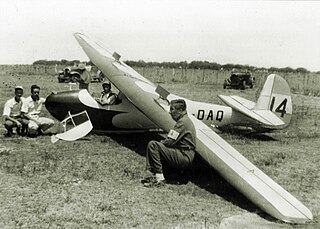
The Schleicher Rhönbussard, otherwise known as the DFS Rhönbussard was intended as an intermediate glider trainer which could also fly competitively. It was designed by Hans Jacobs in Germany in the early 1930s. More than 200 were built.
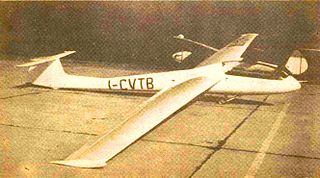
The CVT2 Veltro was an Italian competition glider built in the mid-1950s. Its advanced design incorporated a laminar flow wing, T-tail, retracting undercarriage and a reclining seat to reduce parasitic drag.
The Teichfuss Gabbiano was an Italian, one-off, single seat, high performance glider, designed by Luigi Teichfuss and flown in 1928.
The Teichfuss Astore was an Italian Intermediate single-seat trainer glider designed by Luigi Teichfuss and flown in 1936. Two were built.

The Schleicher Ka-2 Rhönschwalbe is a tandem two-seat training glider designed and built in Germany, in 1952.

The PWS-101 was a high performance Polish glider first flown in 1937. One made the longest distance glider flight in Europe in 1938, gathering prizes for aircraft and pilot.

The Grzeszczyk SG-3 was a Polish single-seat, high performance sailplane first flown in 1933. Between 1934 and 1937 it was Poland's most successful competitor and record setter; about twenty-five were completed.

The Naleszkiewicz JN 1 was an experimental tailless sailplane designed in Poland to explore the aerodynamic properties of a proposed powered tailless aircraft. It proved hard to fly and a crash led to its abandonment after only a few months of limited testing.
References
- 1 2 3 4 5 Simons, Martin. Sailplanes 1920-1945 2nd revised edition. EQIP Werbung und Verlag G.m.b.H.. Königswinter. 2006. ISBN 3-9806773-4-6
- 1 2 3 4 5 "The First British Distance Record" (PDF). Sailplane and Glider: 57. 11 September 1931.[ permanent dead link ]
- ↑ Nevil Shute, "Slide Rule", London: Heinemann, 1954
- ↑ Ellison, Norman (1971). British Gliders and Sailplanes 1922-1970 (1st ed.). London: Adam & Charles Black. p. 81.
- Simons, Martin. Sailplanes 1920-1945 2nd revised edition. EQIP Werbung und Verlag G.m.b.H.. Königswinter. 2006. ISBN 3-9806773-4-6
- "The First British Distance Record" (PDF). Sailplane and Glider: 57. 11 September 1931.[ permanent dead link ]